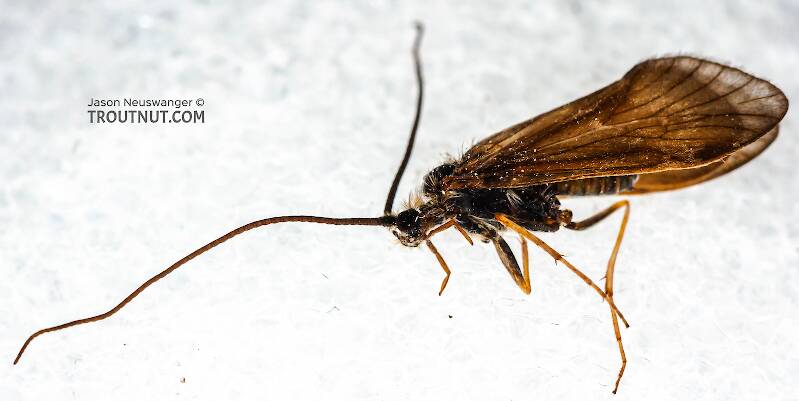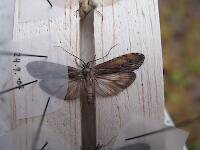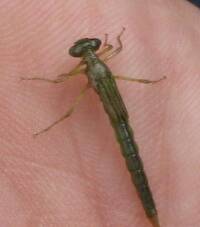
Hex Mayflies
Hexagenia limbata
The famous nocturnal Hex hatch of the Midwest (and a few other lucky locations) stirs to the surface mythically large brown trout that only touch streamers for the rest of the year.
Featured on the forum

This specimen resembled several others of around the same size and perhaps the same species, which were pretty common in my February sample from the upper Yakima. Unfortunately, I misplaced the specimen before I could get it under a microscope for a definitive ID.

Troutnut is a project started in 2003 by salmonid ecologist Jason "Troutnut" Neuswanger to help anglers and
fly tyers unabashedly embrace the entomological side of the sport. Learn more about Troutnut or
support the project for an enhanced experience here.
Troutnut on May 18, 2007May 18th, 2007, 11:54 am EDT
The pictures aren't nearly good enough for me to actually follow a key, but I'm pretty curious. This species was out in smaller numbers alongside prolific Brachycentrus flies. Based on the long antennae I'm going to initially guess Leptoceridae, but I don't think that's right. It just doesn't look like the other Leptoceridae on this site, and then antenna, though long, aren't as long as theirs.
Jason Neuswanger, Ph.D.
Troutnut and salmonid ecologist
Troutnut and salmonid ecologist
Litobrancha on May 19, 2007May 19th, 2007, 6:47 pm EDT
definitely not a leptocerid. man you have some interesting looking pics. can you take pictures of the thorax segments in dorsal view? that would help, also wings spread with view of fore and hind wings and genitalia segments. many of these are males and should be identifiable at least to family or genera, if not species.
GONZO on May 20, 2007May 20th, 2007, 7:12 am EDT
Just a guess, but might this be Lepidostoma?
Litobrancha on May 23, 2007May 23rd, 2007, 3:14 am EDT
isn't this the same specimen that i suggested might be apatania?
not a lepidostomatid, coloration isnt right and the maxillary palps would be bizarro and hairier.
not a lepidostomatid, coloration isnt right and the maxillary palps would be bizarro and hairier.
Troutnut on May 23, 2007May 23rd, 2007, 4:11 am EDT
Litobrancha,
It's not the same specimen, but it is very similar. I've moved it to Apatania for now.
Jason
It's not the same specimen, but it is very similar. I've moved it to Apatania for now.
Jason
Jason Neuswanger, Ph.D.
Troutnut and salmonid ecologist
Troutnut and salmonid ecologist
GONZO on May 23, 2007May 23rd, 2007, 5:27 am EDT
Lito--Thanks for that "bizarro and hairy palp" character for Lepidostoma, it's useful and descriptive. :)
Jason--As far as I can determine, incerta is the only Apatania recorded for NY. (And the other PA species are not recorded near the Delaware.)
Jason--As far as I can determine, incerta is the only Apatania recorded for NY. (And the other PA species are not recorded near the Delaware.)
Troutnut on May 23, 2007May 23rd, 2007, 8:48 am EDT
Okay, I'll tentatively place it in that species, then.
Jason Neuswanger, Ph.D.
Troutnut and salmonid ecologist
Troutnut and salmonid ecologist
Creno on Dec 22, 2007December 22nd, 2007, 9:36 am EST
Folks - I don't think this is Apatania. From what I can see the palps, spurs, venation don't seem right. I am guessing but it looks to me like the maxillary palps are folded up in front of the face and the large three segmented palps you can see are the labial palps. I would guess it is the male of the brachydcentrid you were seeing.
Entoman on Jul 30, 2011July 30th, 2011, 11:32 am EDT
Another example of the value of Jason's "related discussions" list. This one fell through the cracks and is worthy of a revisit - especially because it affects the hatch page.
Brachycentrus males look quite different from the females in terms of both size and appearance which explains the difficulty in easily associating them streamside. What I can't explain is why the wing shape looks more like Apatania. Besides the slenderer appearance, the top rear facet is much shorter and starts further back on the wing than what I'm used to seeing on Grannoms.
Still, I think Dave is right. At least for the following reasons I can make out:
1. Foreleg spurs - this specimen has two, Apatania has only one.
2. Protuding warts on the pronotum of Brachycentrus - a very subtle distinction, but it is noticable upon close inspection, and this specimen appears to have it.
3. The hairs along the rear leading edge of the forewings are much longer and more obvious with Apatania.
Though the 2-3-3 spur formula is the most common in this genus, one species can have the 2-2-3 formula this specimen has. Together with the brown wings, this makes me think Brachycentrus americanus.
Dave, please help with this and/or correct me where I've gone wrong.
Regards,
Kurt
Brachycentrus males look quite different from the females in terms of both size and appearance which explains the difficulty in easily associating them streamside. What I can't explain is why the wing shape looks more like Apatania. Besides the slenderer appearance, the top rear facet is much shorter and starts further back on the wing than what I'm used to seeing on Grannoms.
Still, I think Dave is right. At least for the following reasons I can make out:
1. Foreleg spurs - this specimen has two, Apatania has only one.
2. Protuding warts on the pronotum of Brachycentrus - a very subtle distinction, but it is noticable upon close inspection, and this specimen appears to have it.
3. The hairs along the rear leading edge of the forewings are much longer and more obvious with Apatania.
Though the 2-3-3 spur formula is the most common in this genus, one species can have the 2-2-3 formula this specimen has. Together with the brown wings, this makes me think Brachycentrus americanus.
Dave, please help with this and/or correct me where I've gone wrong.
Regards,
Kurt
"It's not that I find fishing so important, it's just that I find all other endeavors of Man equally unimportant... And not nearly as much fun!" Robert Traver, Anatomy of a Fisherman
Creno on Jul 30, 2011July 30th, 2011, 12:34 pm EDT
I cannot help much more with these photos. The palps are brachycentrid, not apataniid. The maxillary palps of brachycentrids are 3 segmented and folded up in front of the face; and the 3 segmented labial palps are long and flattened. I am always cautious about spur counts because you cannot see both sides of the tibia and they often break off, although the basal pit remains if you have the specimen in hand. I did look at the venation better this time (copy the first pic to a pic editor and convert to a negative and you can see venation fairly well). If you have access to the major caddis taxonomic works for venation comparisons you will see the distinct brachycentrid venation - not the distinct Apatania venation.
hope this helps
creno
hope this helps
creno
Entoman on Jul 30, 2011July 30th, 2011, 2:06 pm EDT
Hi Dave,
Thanks for the help. Nothing causes me more second guessing than comparing subtle (and sometimes not so subtle) venation patterns. Are you referring to the lack of crossveining running more or less in a jagged line across the forewing approx. 1/3 wing length or so from the end?
Just to clarify regarding spur counts, I'm hoping you are commenting about the unreliability of using spur formulas from photos in general. One of these photos clearly shows two foreleg spurs so breakage or lack of view is not an issue in this case. To my understanding Apatania species only have one, so was counting on that as being significant.
regards,
Kurt
Thanks for the help. Nothing causes me more second guessing than comparing subtle (and sometimes not so subtle) venation patterns. Are you referring to the lack of crossveining running more or less in a jagged line across the forewing approx. 1/3 wing length or so from the end?
Just to clarify regarding spur counts, I'm hoping you are commenting about the unreliability of using spur formulas from photos in general. One of these photos clearly shows two foreleg spurs so breakage or lack of view is not an issue in this case. To my understanding Apatania species only have one, so was counting on that as being significant.
regards,
Kurt
"It's not that I find fishing so important, it's just that I find all other endeavors of Man equally unimportant... And not nearly as much fun!" Robert Traver, Anatomy of a Fisherman
GONZO on Jul 30, 2011July 30th, 2011, 3:33 pm EDT
Wow..."Lepidostoma"? I have no idea what made me think that was a possibility. Musta been off my meds.
My impression was that one thing that makes B. americanus rather unique is that (compared to the very compact emergence of the more familiar eastern spring-emerging Brachycentrus spp.) it typically has an extended summer emergence. Might it be more likely that this is a male of one of the more common eastern species in that area, like B. solomoni or B. nigrosoma?
Though the 2-3-3 spur formula is the most common in this genus, one species can have the 2-2-3 formula this specimen has. Together with the brown wings, this makes me think Brachycentrus americanus.
My impression was that one thing that makes B. americanus rather unique is that (compared to the very compact emergence of the more familiar eastern spring-emerging Brachycentrus spp.) it typically has an extended summer emergence. Might it be more likely that this is a male of one of the more common eastern species in that area, like B. solomoni or B. nigrosoma?
Entoman on Jul 30, 2011July 30th, 2011, 5:05 pm EDT
Hi Lloyd,
I must plead ignorance of the emergence timing and abundance of the species you mentioned. I know that numerosus is supposed to be prolific back there, but this guy looks like the classic Grannoms we get in the West. Our hatches can get unbelievably concentrated in the Spring. But again, Spring is a relative thing out here. At altitude they can be prolific all Summer long.
Even though this is an eastern specimen, what made me think americanus was the brown wing (ours can be the same or a little darker) and lack of vertical uneven striping or blotch arrangements usually evidenced in males with the other species. These markings can be quite muted, but still observable in the hand.
If one of the species you mentioned has plain brown wings (as observed in the hand), let's move it there instead.
Regards,
Kurt
I must plead ignorance of the emergence timing and abundance of the species you mentioned. I know that numerosus is supposed to be prolific back there, but this guy looks like the classic Grannoms we get in the West. Our hatches can get unbelievably concentrated in the Spring. But again, Spring is a relative thing out here. At altitude they can be prolific all Summer long.
Even though this is an eastern specimen, what made me think americanus was the brown wing (ours can be the same or a little darker) and lack of vertical uneven striping or blotch arrangements usually evidenced in males with the other species. These markings can be quite muted, but still observable in the hand.
If one of the species you mentioned has plain brown wings (as observed in the hand), let's move it there instead.
Regards,
Kurt
"It's not that I find fishing so important, it's just that I find all other endeavors of Man equally unimportant... And not nearly as much fun!" Robert Traver, Anatomy of a Fisherman
GONZO on Jul 30, 2011July 30th, 2011, 5:55 pm EDT
If one of the species you mentioned has plain brown wings (as observed in the hand), let's move it there instead.
Moving it to Brachycentridae seems safe, and Brachycentrus seems likely, but I wouldn't suggest moving it to any species based on my idle speculation. :)
Creno on Jul 30, 2011July 30th, 2011, 6:54 pm EDT
Kurt - Your spur count of 2 on the forefemur looks correct. The venation characters that are the most obvious for separating the two genera in questions are the shape of the subcosta and radial vein 1 of the forewing.
To keep up with caddis literature one of the sites that is most important is:
http://www.trichopteralit.umn.edu/articles/search
There you can find a pdf of Schmid's classic Genera of Canadian Trichoptera. It probably has venation figures for all the genera you will encounter in a trout stream in NA.
While understanding venation may be more difficult than learning to count spurs, or photograph warts and ocelli, all these characters are are very useful when separating caddis adult genera.
To keep up with caddis literature one of the sites that is most important is:
http://www.trichopteralit.umn.edu/articles/search
There you can find a pdf of Schmid's classic Genera of Canadian Trichoptera. It probably has venation figures for all the genera you will encounter in a trout stream in NA.
While understanding venation may be more difficult than learning to count spurs, or photograph warts and ocelli, all these characters are are very useful when separating caddis adult genera.
Entoman on Jul 31, 2011July 31st, 2011, 10:00 am EDT
Thanks Dave. My trepidation with relying on venation patterns has more to do with looking at photos than specimens in the hand. Besides focus, wing folds, and hairs getting in the way, sometimes I think I'm on to something only to find taking it to the next step involves the hind wings or some other reason that can't be observed. I find this especially frustrating with stoneflies. BTW - thanks for the link, but Schmid's GCT only seems to be available in french there. Is it available anywhere else?
Regards,
Kurt
Regards,
Kurt
"It's not that I find fishing so important, it's just that I find all other endeavors of Man equally unimportant... And not nearly as much fun!" Robert Traver, Anatomy of a Fisherman
Entoman on Jul 31, 2011July 31st, 2011, 10:22 am EDT
Lloyd -
Your pondering the possibility of an alternative eastern species got me thinking. On Dave's suggestion that this specimen may be a male of the coinciding Brachycentrus hatch that Jason mentioned, I went to the hatch pages and found them placed under B. appalachia. It isn't mentioned so I don't know the rationale, but it is my understanding that males of this species have jagged cream stripes or mottlings on their wings. In light of this specimen, after looking at Jason's photos of the females I'm inclined more than ever to think that they are probably americanus. Be that as it may, these photos should probably be together wherever it's decided they should be placed.
Regards,
Kurt
Your pondering the possibility of an alternative eastern species got me thinking. On Dave's suggestion that this specimen may be a male of the coinciding Brachycentrus hatch that Jason mentioned, I went to the hatch pages and found them placed under B. appalachia. It isn't mentioned so I don't know the rationale, but it is my understanding that males of this species have jagged cream stripes or mottlings on their wings. In light of this specimen, after looking at Jason's photos of the females I'm inclined more than ever to think that they are probably americanus. Be that as it may, these photos should probably be together wherever it's decided they should be placed.
Regards,
Kurt
"It's not that I find fishing so important, it's just that I find all other endeavors of Man equally unimportant... And not nearly as much fun!" Robert Traver, Anatomy of a Fisherman
Creno on Jul 31, 2011July 31st, 2011, 1:05 pm EDT
Kurt - you are ready to take on venation but haven't completed french yet? :-) There is an updated English version but it is not free. You don't really need to know french to figure out the venation. It is all figures anyway.
You, like most fishermen, point out the two major "problems" fishers have with most taxonomic works. Taxonomist's expect one to have the specimen in hand with sufficient equipment to examine the specimen correctly. And taxonomists expect others to understand the language they use, even if it is french (or russian, japanese, etc.). We are lucky to have the translation tools today that were not even envisioned when I started into Schmid's caddis works in the 1970's.
Hang in there - like most everything else - it gets easier with time........
creno
You, like most fishermen, point out the two major "problems" fishers have with most taxonomic works. Taxonomist's expect one to have the specimen in hand with sufficient equipment to examine the specimen correctly. And taxonomists expect others to understand the language they use, even if it is french (or russian, japanese, etc.). We are lucky to have the translation tools today that were not even envisioned when I started into Schmid's caddis works in the 1970's.
Hang in there - like most everything else - it gets easier with time........
creno
Entoman on Jul 31, 2011July 31st, 2011, 3:41 pm EDT
Thanks Dave, I will..
"It's not that I find fishing so important, it's just that I find all other endeavors of Man equally unimportant... And not nearly as much fun!" Robert Traver, Anatomy of a Fisherman
Quick Reply
Related Discussions
Topic
Replies
Last Reply
2
Jul 9, 2018
by Martinlf
by Martinlf
7
May 12, 2008
by GONZO
by GONZO
5
Jul 31, 2020
by Creno
by Creno
13
Mar 27, 2008
by Martinlf
by Martinlf
1
Jul 1, 2008
by GONZO
by GONZO






